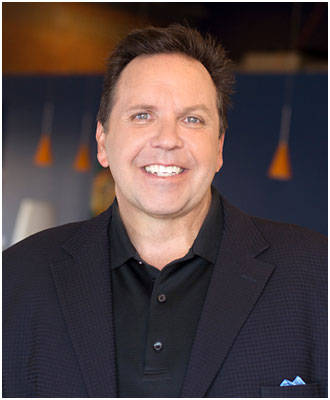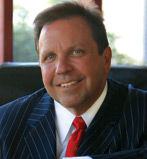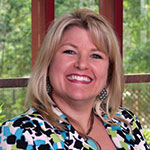The Straight Shot
How Arnold Palmer became the richest athlete in the world.
Sitting in his unpretentious Orlando office, not a trophy in sight, Arnold Palmer bounced from answering calls about a clothing deal in Japan to e-mail about a golf course in Dubai to interviews with reporters from across the United States.
All the while, a most inappropriately named yellow Labrador sat quietly at his feet. Between million-dollar decisions, Palmer scratched the 8-year-old pooch beneath his chin and accepted the dog’s return of affection.
Palmer adopted the dog five years ago when a friend asked for help finding the dog a new home. Palmer and his wife volunteered and decided the dog should keep his name—Mulligan, a do-over taken by a golfer whose first effort wasn’t satisfactory.
“Ironic, huh?” Palmer says with a laugh.
Without question. Arnold Palmer has built his career, both on and off the golf course, by taking no such shots. Palmer always made it a point to try to do things right the first time. And, as any golfer will tell you, if you do things right, mulligans aren’t necessary.
“My father was a golf superintendent when I was growing up in Pennsylvania, in an area of the state where my family had lived since the early 1800s,” the four-time Masters champion says. “His thinking and his motivation were centered around being honest and truthful and keeping a very high level of integrity, simply because that was important to his business as a golf course superintendent. It was important to him that people respected what he did and what he said, and he knew that one way you can make sure that happens is to live your life with integrity. That’s the way I’ve tried to approach my life and my business. That was the greatest lesson he could teach me.”
As a very young boy, Palmer began putting that lesson—and a set of golf clubs his father passed on—to work. He played his first golf at 4, was a caddie by 11 and by high school was the best golfer in Western Pennsylvania. He went to Wake Forest College, where his winning ways continued until he dropped out as a senior to enlist in the Coast Guard. After his three-year stint with the Guard, Palmer worked for a company in Cleveland selling painting supplies so he could resume his amateur golfing career.
In 1954, Palmer was playing a tournament in Eastern Pennsylvania when he met a woman, Winifred Walzer. He fell “helplessly in love” and proposed to her the same week they met. It proved to be a big year for Palmer, who would also go on to win the National Amateur championship and turned pro within months. The following year, he won his first tournament and a whopping $2,400 in prize money. He would go on to win 61 more PGA events before retiring.
In 1958, he won his first Masters championship, and two years later he cemented his reputation as one of golf’s all-time greats. In the 1960 Masters, Palmer birdied the final two holes to come from behind and beat rival Ken Venturi. Television was just beginning to broadcast golf tournaments regularly at that time, and Palmer’s daring style and dashing looks ensured he would be the game’s first made-for-TV champion. Later in 1960, he scored an even more dramatic and improbable comeback, winning the U.S. Open Championship by shooting a 65 on the final day to win a tournament he had trailed by 7 strokes.
Palmer’s aggressive game and strange form—often hitting the ball so hard his follow-through knocked him off-balance—made him the sport’s fan favorite, since so many duffers found themselves swinging just as ungracefully. The galleries that followed Palmer around the course grew and became known as “Arnie’s Army.” He was so popular that he became the first professional athlete to move beyond the standard world of endorsements to the world of business. By all accounts, he became the richest athlete in the world, with a business empire that included golf equipment, clothing, printing, insurance, dry cleaning and the investment industry. His Arnold Palmer companies had offices in Australia, Japan and Europe. Between tournament winnings and earnings from his various businesses, Palmer’s income by the mid-1960s soared to more than $1 million a year.
“Once I started in business, I learned early that it was more important to build a brand than to build a course, design a shirt or put your name on a product,” Palmer tells SUCCESS. “I had a man, Jules Rosenthal, whose role in the company was as a senior vice president in charge of licensing. Jules became a great teacher for me. I remember back in the early ’60s, when everything was going great for us on the course, one day I said to him, ‘It’s easy for you to run my clothing business now, while I’m playing golf and doing things to attract attention, but what happens when I’m not playing golf and doing as well as I am currently?’ And he said, ‘Arnie, I will have you as a brand. Your name won’t be just your name. It will be a brand name. That’s what we’re building now. You will continue as long as you want to continue. Just do the things that earned you that brand and the brand will live on.’ Boy, was Jules right.”
With Jules helping keep the business on track, Palmer continued to build his brand on the course. In some ways, Jules did a better job. Palmer won his last major tournament in 1964, yet his brand grew in value each year, whether he was winning golf tournaments or not.
“You never stop building a brand,” Palmer says, repeating the advice Jules gave him whenever they spoke. “And because of that constant approach, our brand is something that’s recognized more in Asia—Korea, China, Japan—than it is in the United States. We started with a company in Tokyo and built our brand of golf shirts, sweaters and menswear. In the ensuing years, we’ve designed women’s clothes and children’s lines. We used great women golfers to help build the Arnold Palmer brand. Everything says Arnold Palmer. That’s the brand. In addition to growing it, we have to police it very carefully, protect the brand daily.”
Palmer shows up for work, Mulligan in tow, each morning shortly after 8. He’s done so for more than 50 years and doesn’t intend to stop.
“I’m 79 years old and still go to work every day,” he says. “Working motivates me. Working invigorates me. The things we’re doing invigorate me. Even going out and hitting golf balls, though I can’t hit them like I used to or the way I’d like to hit them, I still have the desire and enjoy the challenge of trying to hit every shot just right. That desire to build things and do things right, that’s what keeps me going. I would demise if I didn’t have the desire to do things, build things. At this stage, there’s no question that I’m impacted by the fact I’m getting older and want to see everything I do through to its end; I want to see them built or on the shelves. I want to see all that we have happening now get where we’ve planned. That’s quite a motivator for me. That keeps me going daily.”
At the centerpiece of Arnold Palmer Enterprises is his golf course-design company. He identified course-design work as a passion while helping his father turn the nine-hole Latrobe course where he worked into an 18-hole challenge.
“I drove a bulldozer then, helping shape the second nine holes,” Palmer says. “I enjoyed the work, and I knew then that this was a great opportunity to create something. Not long after, some folks from over in the Allegheny Mountains offered me the chance to build an entire course for them. I knew that one day my golf wouldn’t be of the caliber that it would have to be to stay out there and play with the young guys like they are today, but the challenge of trying to compete with younger guys inspired me to keep playing, always knowing that I could learn something from every course I played. Now, if you look at my desk, I’ve got copies of course designs from everywhere in the world on my desk—from China, from Japan, Korea, Dubai, Singapore, Hong Kong. We have golf courses just about everywhere. We have somewhere between 20 and 25 courses in some phase of construction right now, and we’ve done right at 300 total.”
That last number puts him a little behind his longtime rival, Jack Nicklaus, whose Nicklaus Design has served as designer for 337 courses, according to his Web site.
“I enjoy having Jack as a competitor,” Palmer says, his eyes narrowing. “It always helps to have a great one competing with you. And I like the fact that he and I are competing today as much as we ever did on the golf course. We compete in business, in golf course design. Jack is very big. Now, he’s a few years younger, and has the ambition and desire to travel a lot more than I do at this point, and to keep this going you have to travel a little more than I’m willing to travel. I’m cutting back in my world travel, but still communicating with people around the world. He’s willing to get on that jet and go to South Africa. If I go, it’s as part of a trip.
“So his willingness to travel means that right now he’s probably doing a little better than I am…” Palmer trails off, before adding with a winner’s wit. “But he knows I’m here. I’m always over his shoulder. That’s the fun of it.”
In addition to his work, Palmer placed a priority on giving back, helping to create the Arnold Palmer Pavilion at the University of Pittsburgh Medical Center near his hometown, as well the Arnold Palmer Hospital for Children in Orlando. After undergoing successful prostate cancer treatment in 1997, he has become a strong advocate for programs supporting cancer research and early detection, including the Arnold Palmer Prostate Center in California and his “Arnie’s Army Battles Prostate Cancer” campaign, which has raised 1.5 million dollars.
Arnold and Winnie Palmer had two daughters, seven grandchildren and two great-grandchildren. Winnie passed away in 1999 from cancer. Palmer and his second wife, Kathleen “Kit” Gawthrop, married in 2005.
There’s little on Arnold Palmer’s to-do list that he hasn’t accomplished. “I wanted to fly, and now I get to pilot my own jet, a Cessna Citation X,” Palmer says. “Flying motivates me to work, especially with the cost of fuel. But if there were something I have always wanted to do, it would be to build a golf course that I built my way. All of the golf courses we do are for people or corporations. I have not yet done a golf course entirely the way I want to do it. I always have to take their wishes into account or the land plan or the budget. Take those restrictions away, and I would build a course unlike anything we’ve built yet. I haven’t given up on that desire to do just one golf course where everything done would be done the way I’d like to see it. Maybe one day.”
Palmer says his health is good, so time isn’t a factor as he holds onto that hope. If built, it would be the crown jewel of his lifetime in business.
“I clearly enjoy doing business,” he says. “I enjoy finding and meeting people who respect me for more than just being an athlete or a good golfer. I want them to work with me because of the way I think and the way I run my businesses. It was integrity that I wanted to bring to work every day.” And he brings Mulligan, too.
Tags: Success Magazine, Writing






